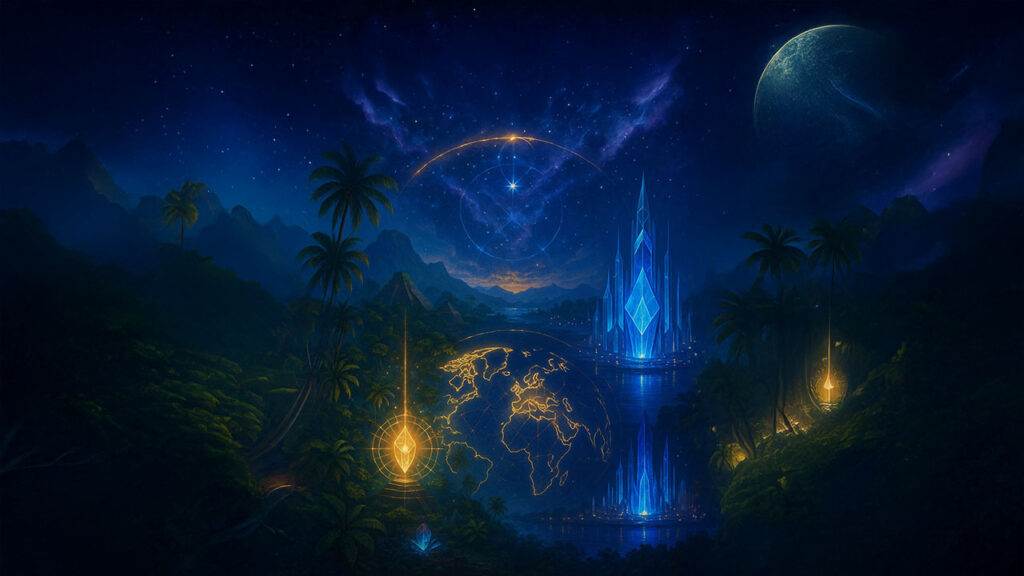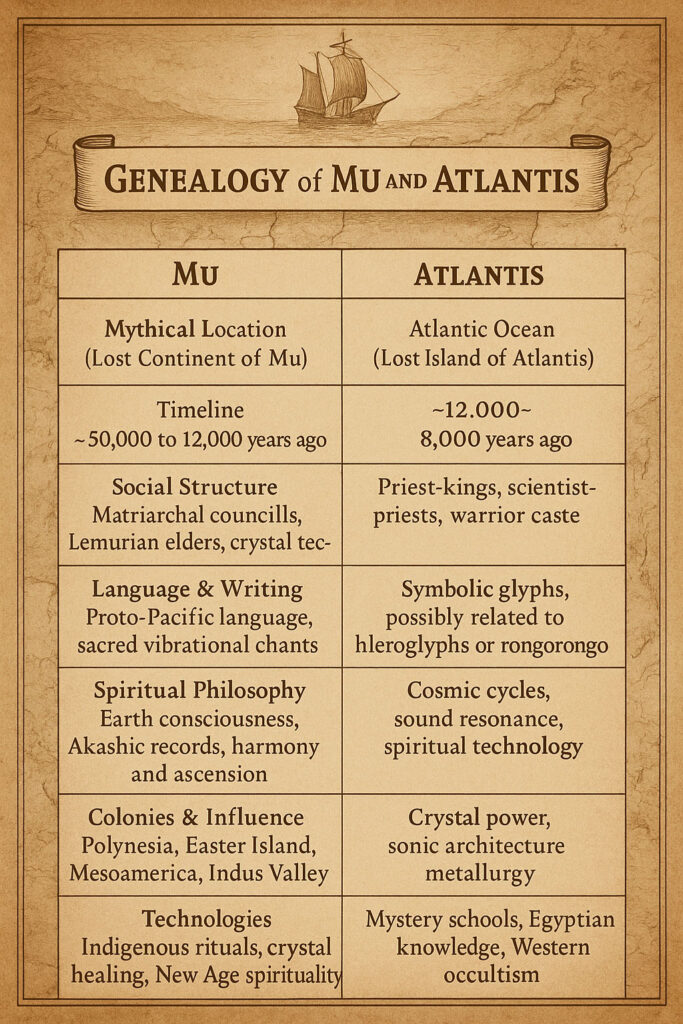Genealogical Account of Mu and Atlantis: Part One

Mythical Origins and Timelines
Mu
According to the writings of James Churchward in the early 20th century, Mu was a vast continent located in the Pacific Ocean, believed to have existed around 50,000 to 12,000 years ago. Churchward claimed Mu was the cradle of an ancient civilization whose people spread across the Pacific, influencing many island cultures. Though no archaeological evidence supports this, the concept of Mu has permeated esoteric thought and New Age beliefs.
Legend holds that Mu was the last remnant of the even older continent of Lemuria, whose elders were said to be highly spiritual beings with profound psychic abilities. Mu’s civilization reportedly thrived on advanced crystal technologies and had a harmonious relationship with the earth’s natural energies.
Its decline is mythically attributed to a cataclysmic series of earthquakes and floods that sank the continent beneath the waves, dispersing its people across the Pacific and beyond.
Atlantis
Atlantis is first described by Plato around 360 BCE as an advanced island nation that existed roughly 9,000 years before his time — placing it around 11,000–12,000 years ago. According to Plato, Atlantis was a naval power with vast wealth and technology but fell into moral decay, resulting in its destruction by a natural catastrophe.
Esoteric traditions, such as those popularized by Helena Blavatsky and Edgar Cayce, envision Atlantis as a highly advanced civilization possessing not only remarkable technology (including crystal power sources) but also sophisticated spiritual knowledge. Some accounts claim Atlantis had multiple eras of civilization, from a golden age of wisdom to a darker, warlike phase before its demise.
Cultural Identity: Language, Social Structure, and Spiritual Philosophy
Mu
Language: The Muans reportedly spoke a proto-language thought to be ancestral to many Polynesian and Native American tongues. This language may have contained sacred vibrational elements, used in ritual chants and crystal-activated communications.
Social Structure: Mu is often described as a matriarchal society governed by wise elder councils, particularly Lemurian elders who preserved ancient spiritual wisdom. The ruling class included priestesses and “crystal technocrats,” individuals who managed the continent’s vast energy grid.
Spiritual Philosophy: Muans revered the earth as a living organism, aligning their cities and temples with ley lines and energetic vortexes. Their philosophy emphasized balance, harmony, and ascension through meditation and the use of crystalline energy. They believed in reincarnation and maintained Akashic records — metaphysical archives of all human knowledge.
Atlantis
Language: Atlanteans purportedly used a complex script or set of glyphs, possibly related to the Egyptian hieroglyphs or even the undeciphered Rongorongo script of Easter Island, suggesting a highly symbolic and sound-based written form.
Social Structure: Atlantis was structured as a hierarchical society led by priest-kings, warriors, and scientists. The priest-kings were considered divine intermediaries who controlled both spiritual rites and the operation of crystal technologies powering their civilization.
Spiritual Philosophy: Atlantean spirituality combined practical science with metaphysical principles. They believed in cosmic cycles and the influence of planetary energies on human consciousness. Their temples were built to harness sound resonance and light frequencies, facilitating healing and psychic development.

Expansion Beyond Core Territories and Colonies
Mu Colonies and Affiliates
Polynesia and Easter Island: Many legends suggest Muans voyaged across the Pacific, founding settlements in Polynesia. The massive Moai statues of Easter Island are sometimes interpreted as symbolic remnants of Mu’s ancestral memory, guardians of sacred energy points.
Mesoamerica: Speculative links connect Mu to early Olmec and Maya civilizations, suggesting the transmission of pyramid architecture and crystal-based rituals.
The Indus Valley: Some theorists propose Muan refugees traveled westward, influencing the early Harappan culture’s urban planning and spiritual symbolism.
Atlantis Colonies and Affiliates
Egypt: Atlantean influence is often linked to the rise of ancient Egypt. Pyramid construction, advanced astronomy, and priestly hierarchies show parallels with Atlantean models.
Mediterranean Outposts: The island of Thera (Santorini) and Crete are speculated to have been Atlantean colonies or trading centers, spreading technological innovations such as aqueducts and metallurgy.
Americas: Some fringe theories propose Atlantean survivors crossed the Atlantic to influence pre-Columbian civilizations, including the Aztecs and Incas.
Cultural and Technological Transmissions
Crystal Energy Systems: Both Mu and Atlantis are credited with harnessing the power of crystals, not only for energy but also for communication, healing, and spiritual amplification. These systems allegedly involved crystal matrices embedded in temples and artifacts.
Sound-Based Architecture: Temples and cities were designed to resonate with specific frequencies, amplifying psychic abilities and healing energies. Atlantean engineers are often imagined to have used “sonic levitation” and vibrational technologies to build massive structures.
Advanced Navigation: Both civilizations are said to have possessed star maps and navigational instruments far beyond their time, enabling oceanic voyages and planetary alignment rituals.
Hierarchy of Power and Preservation of Knowledge
Mu: Governed by councils of elder priestesses and crystal technocrats, knowledge was passed orally and through encoded crystalline records. Spiritual ascension and the safeguarding of Akashic records were paramount.
Atlantis: Ruled by priest-kings supported by scientist-priests who managed technology and religious rites. Knowledge was stored in hidden libraries and in “Akashic archives,” accessible only to initiates.
With their cataclysms, much of this knowledge was lost or fragmented, preserved only in myths, oral traditions, and esoteric teachings.
